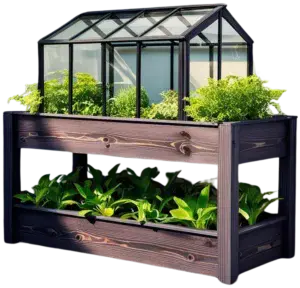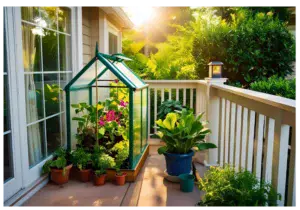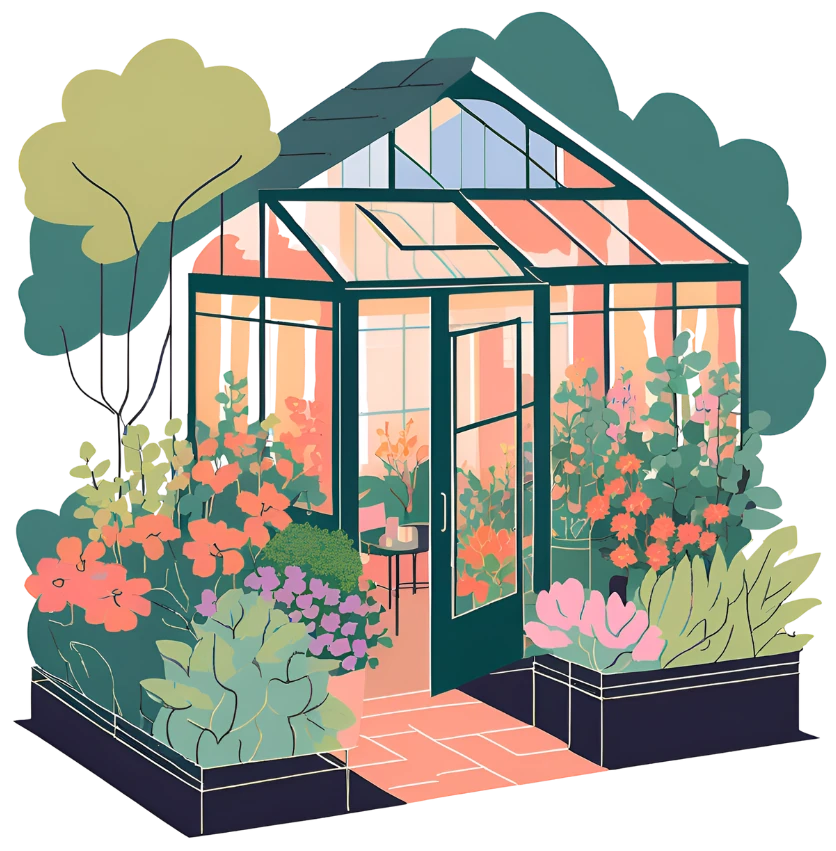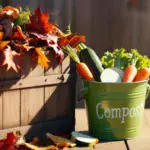Urban and small space gardening is a booming business! And standing at the forefront of this movement towards urban sustainability is the mighty urban greenhouse. A self-sufficient urban greenhouse also becomes your personal garden oasis—right in the heart of the city. A greenhouse has made this type of this garden retreat a reality for many people. You get fresh, hand-grown produce, always available right at your fingertips. City dwellers and those in smaller homes often garden to reduce their dependence on store-bought produce. And the numbers of those who have decided to give it a try are rising almost daily.
If you have a few square feet in your backyard, patio, balcony or maybe even on a rooftop, you can be well on your way. A greenhouse makes it possible to grow a surprising amount of food right in the city. You can create a space that reflects your garden vision and fits your urban lifestyle—it’s all within reach.
It’s not magic—just smart planning and thoughtful crop selection. Whether you’re adding a little lettuce to your diet or skipping grocery trips, the right greenhouse makes it a joy. The aim is to squeeze every drop of potential out of your growing space. This way of living promotes health and sustainability. And it makes for a fresher, healthier diet from all the flavorful food crops you have raised in your own productive little garden.
Whether you’re motivated by the health benefits. Or maybe it’s the joy of gardening, or just the convenience of having a food source right by your door. A greenhouse could be your ticket to a more self-sufficient way of living It’s more than just gardening. It’s about a lifestyle that bridges urban life with the pleasures and rewards of cultivating your own food.
Choosing the Right Greenhouse Size: Needs and Space Constraints
 Finding the right size for your urban greenhouse is the key to making the most of your available space. It’s not a one-size-fits-all scenario. The size of your greenhouse ties directly into what you plan to grow and how much produce you aim to harvest. Whether it’s adding a bit of lettuce to your diet or reducing all the trips to the grocery store the right greenhouse makes it a joy.
Finding the right size for your urban greenhouse is the key to making the most of your available space. It’s not a one-size-fits-all scenario. The size of your greenhouse ties directly into what you plan to grow and how much produce you aim to harvest. Whether it’s adding a bit of lettuce to your diet or reducing all the trips to the grocery store the right greenhouse makes it a joy.
Look at how much room you have, or more importantly, look at how much room you’re willing to devote to your greenhouse vision. Your family’s food needs are the compass guiding your decision. Bigger families might need more space for planting, while a smaller setup can work well for fewer people.
Also, factor in the climate. In cooler regions, a slightly roomier greenhouse might be necessary to account for any additional insulation materials.
Another handy tip to keep in mind is that space efficiency doesn’t mean you have to skimp on quantity. Even a small 6-by-8-foot greenhouse can support a diverse harvest—if planned wisely. From compact tomato varieties to a vibrant herb patch, strategic choices make the space do double duty.
The sweet spot lies in balancing how much space you’re using with the production you’re getting out in return. Walking this line helps to integrate your greenhouse into your urban lifestyle without feeling cramped or overwhelming. Ultimately, a greenhouse should be an enhancement not an imposition, on your life.
Here is a fast inexpensive idea to help your plants next winter. DIY Mini Greenhouse for Winter Plant Protection
Maximizing Yield in Small Spaces: Wise Crop Choices:
Picking the right crops will set the stage for a successful greenhouse experience. Every seed you sow holds the potential for a bountiful harvest if you do it the right way. This is where choosing high-yield crops for small spaces is brought into play.
Start by choosing leafy greens like lettuce and spinach, which not only grow fast but will keep giving. A little effort delivers a lot of fresh, tasty and healthful goodness to your table.
And don’t leave out the herbs. Basil, parsley, cilantro, and mint thrive even in the tightest corners. A few pots or a small shelf is enough to ensure a steady supply of fresh flavors for your kitchen creations.
Then there’s the appeal of compact root veggies. These are plants like radishes and carrots, which don’t need much room and they grow fast, delivering up a solid crop in no time.
Compact tomatoes, such as ‘Tiny Tim’ or ‘Patio Princess’, made for those small-constrained environments. They are the gift that keeps on giving, providing you with a regular supply of juicy, sweet fruit.
And let’s not skip strawberries, which fit beautifully in hanging baskets. Strawberries add both beauty and some of the healthiest snacks you can eat, all right there in your greenhouse.
For those who are thinking vertically, climbing crops like peas and pole beans always rise to the occasion, saving valuable ground space while climbing upwards.
Peppers, cabbage, and bok choy are your go-to crops for compact but nutritious additions to your greenhouse gang. Bok-choy is a staple of many oriental dishes and is easy to grow. Pairing these plants wisely not only boosts your yield but also maximizes every square inch of your available grow patch.
Choosing wisely will essentially boil it down to the understanding of what grows best in the environment you’ve created. Every plant has its quirks and strengths, and playing to those quirks and strengths will make the whole growing process a lot smoother and more enjoyable.
Space Optimization Techniques: Every Inch Counts!

When space is at a premium, every square foot is precious and may have to work a little overtime. Maximizing your greenhouse space is the target in this game. and there are a few useful strategies available to make it happen.
One strategy is succession planting. which is an old and trustworthy technique. Succession planting is done by planting a new crop as soon as the first crop has been harvested. This will keep your garden in perpetual motion, ensuring that there’s always something fresh growing in your garden.
High-density planting is another space saving method that will give you a boost by allowing you to pack greens, herbs, and root vegetables close together. It’s an all-you-can-plant buffet! simply by using every bit of soil.
Vertical growing takes this efficiency and shifts it upwards. Trellises, hanging baskets, and shelves use a smaller, or no, footprint in the growing area using up less ground and creating a multi-layered fresh-produce production plant.
Container and shelf gardening aren’t only practical, they offer much needed flexibility. If you want to move your plants around to catch the best sun, no worries!
Do you love the idea of a tiered garden? Some shelves will make that a reality while optimizing every inch of vertical space.
And let’s not forget the power of year-round growing. Utilizing thermal mass, such as water barrels, lets you extend your growing season so those veggies will keep coming even when the frost starts nipping at the window.
Companion planting is like matchmaking for plants. Smart pairings—like basil with tomatoes—boost growth, save space, and increase your harvest.
And then we have the more modern techniques, like hydroponics and aquaponics, if you want high yields without traditional soil. These soilless methods are efficient and perfect for tight spots. They will speed up growth rates significantly.
These strategies all play into a key principle: doing more with less. By tweaking how you plant, it’s possible to grow a wide, varied and abundant harvest even in a small greenhouse, creating a mighty food-factory that’s both efficient and very rewarding.
Achieving Longevity and Sustainability
You’ll find that creating a thriving urban greenhouse is a little bit more than just choosing the right crops and methods, it becomes more like building, then maintaining a well-oiled machine season after season. Here are some essential practices to follow for your thriving Urban Greenhouse.
The one challenge that can arise is cost as greenhouses aren’t always cheap. Building your own might be your cost-effective answer, especially if you’re handy with tools and love a DIY project. On the flip side, pre-fabricated greenhouses offer simplicity and come ready to set up. The choice boils down to your budget, skills, available time and priorities.
Greenhouses can also have their hiccups. First there’s the cost of the investment, then there’s the regular maintenance, space constraints, the potential for climate issues inside your greenhouse. Also, there is sometimes a bit more complexity involved than when growing in a traditional garden setup. Planning ahead for these challenges can mean the difference between frustration and enjoying healthy, home-grown produce at your table.
Ventilation is also very crucial. A greenhouse will get humid, warm and stuffy. Proper airflow prevents overheating and keeps mold at bay. Keeping an eye on climate with tools like thermometers and hygrometers will help you to maintain an optimal environment for your plants and encourage robust growth.
Even the unheated greenhouse isn’t off the table for the resourceful gardener. Certain hardy plants can survive a mild winter, and by using row covers and/or insulating materials you can further extend your growing season. Another option is purchasing a greenhouse heater, there many options available. Some are high-tech and carry a high price tag, but there a number of greenhouse heaters available and many are very affordable.
Now toss in some clever tricks, like using reflective surfaces to redirect light back to your plants, and these little touches can make a big difference. Crop rotation is another ace up your sleeve, it helps keep the soil rich and disease-free.
Add these practices to your routine, and your greenhouse becomes a self-sustaining ecosystem—producing fresh food with just basic care and the occasional tweak. By sticking to these foundations, you’ll cultivate not just plants but a lifestyle that’s healthier. And what gets better than a healthy connection to Mother Earth.
Happy Gardening




